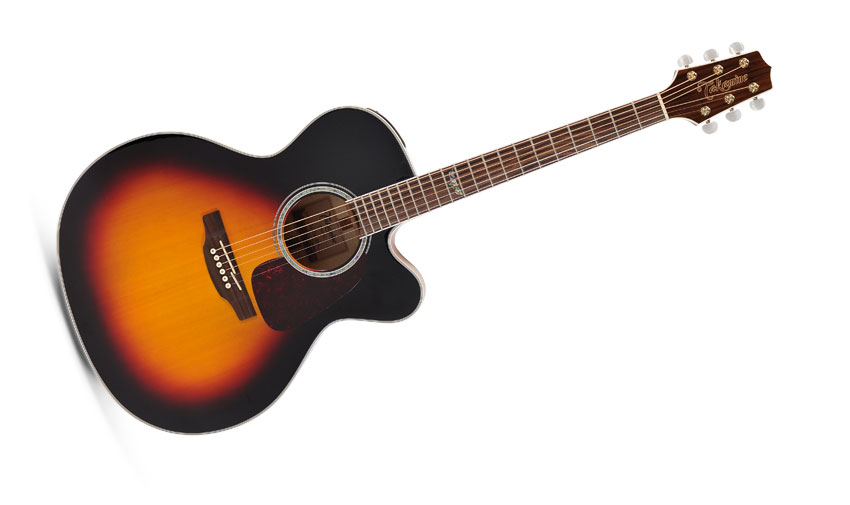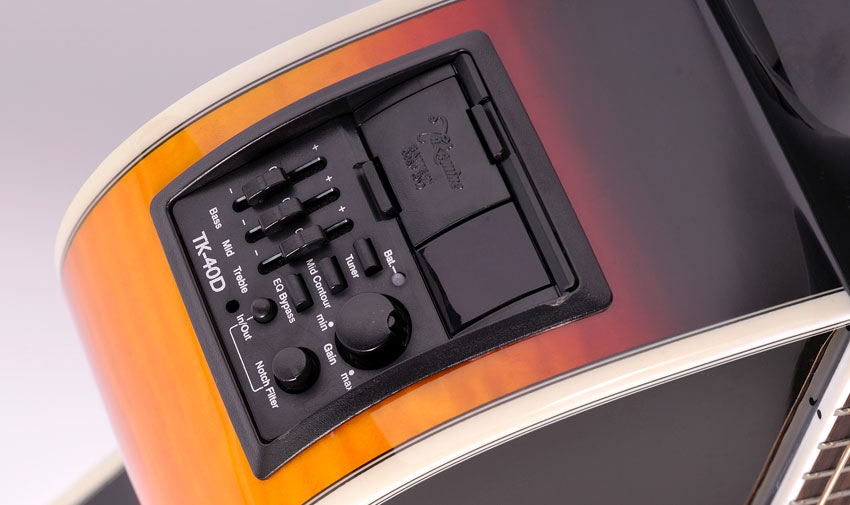MusicRadar Verdict
For general use, this is a good-looking, well-made stage-ready electro.
Pros
- +
Great value for money. Excellent playability.
Cons
- -
No tuner-mute or phase switch.
MusicRadar's got your back

Takamine GJ72CE-BSB

Preamp

Finish
The Takamine house was built on its electro-acoustic pickup and preamp systems. Of course, its guitars weren't too shabby either, and as well as high-line Japanese-made guitars, there are these more affordable Chinese-made G Series instruments.
Our review sample comes from the all-cutaway electro 70 Series that includes the same-priced dreadnought, the smaller NEX, and our reviewed six-string jumbo that's paired with a 12-string (at £562). Each model is offered in both this evocative looking 'burst or natural finish.
At 435mm (17.13 inches) across its bulbous lower bouts, combined with a 120mm (4.72-inch) body depth, the GJ72CE is huge. Construction centres on a solid spruce X-braced top with laminated maple back and sides, which have a subtle flame figure.
Embellishments are minimum: off-white binding, inner multi- stripe purfling and a little bit of abalone detail to the concentric soundhole rings. That said, a 'reversed mountain' abalone inlay at the 12th fret looks like it's been installed upside down. Anyway...
"What we have is a very clean, clear and crisp high-end with a well balanced midrange and slightly tightened, defined lows"
Playability is superb. The neck has a chunky C section topped with a bound rosewood 'board with a Gibson-like 305mm (12-inch) camber and medium-gauge frets giving a familiar electric-like feel; likewise the 43mm (1.69-inch) nut width and 52.5mm (2.07-inch) string spacing across the two-piece bridge saddles. Intonation is virtually spot on; only the G string is slightly sharp at the 12th fret. String height is low, too - again, very electric-like.
Sound shaping is taken care of by the three-band EQ sliders and the mid-contour switch. Unusually, there's an EQ bypass button - handy for DI recording, where you can send a flat signal in and EQ it afterwards as your track develops, all without altering your onstage EQ settings.
The notch filter has a simple in/out switch and a rotary control to filter out the feedback- creating frequencies. The tuner is big and quite bright, but doesn't mute your output for silent tuning.
Want all the hottest music and gear news, reviews, deals, features and more, direct to your inbox? Sign up here.
Big-bodied jumbos don't always have the largest acoustic sounds, and here, that's pretty true; what we have is a very clean, clear and crisp high-end with a well balanced midrange and slightly tightened, defined lows. It's a superb strummer from the feel of that neck through to the balanced sound.
Amplified, the EQ is broad and adequate; a little low-end lift certainly warms things up. The mid-contour switch doesn't provide a preset sound, but alters the frequency centre of either the boosted or cut midrange slider.
For general use, this is a good-looking, well-made stage-ready electro. However, no tuner-mute function is odd, and the addition of a phase switch - which often cures feedback instantly - would have been welcome. Mind you, with street prices around £450, it's a little churlish to complain.
Dave Burrluck is one of the world’s most experienced guitar journalists, who started writing back in the '80s for International Musician and Recording World, co-founded The Guitar Magazine and has been the Gear Reviews Editor of Guitarist magazine for the past two decades. Along the way, Dave has been the sole author of The PRS Guitar Book and The Player's Guide to Guitar Maintenance as well as contributing to numerous other books on the electric guitar. Dave is an active gigging and recording musician and still finds time to make, repair and mod guitars, not least for Guitarist’s The Mod Squad.
